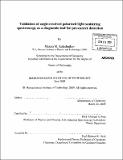| dc.contributor.advisor | Michael S. Feld. | en_US |
| dc.contributor.author | Kalashnikov, Maxim M | en_US |
| dc.contributor.other | Massachusetts Institute of Technology. Dept. of Chemistry. | en_US |
| dc.date.accessioned | 2009-11-06T16:28:38Z | |
| dc.date.available | 2009-11-06T16:28:38Z | |
| dc.date.copyright | 2009 | en_US |
| dc.date.issued | 2009 | en_US |
| dc.identifier.uri | http://hdl.handle.net/1721.1/49744 | |
| dc.description | Thesis (Ph. D.)--Massachusetts Institute of Technology, Dept. of Chemistry, 2009. | en_US |
| dc.description | Vita. | en_US |
| dc.description | Includes bibliographical references. | en_US |
| dc.description.abstract | Light scattering spectroscopy has emerged as a valuable diagnostic tool for cancer diagnoses in the past ten years. The interaction of light with cellular structures brings out information about morphological changes accompanying malignancy at early stages. The virtue of this technique is to extract key morphological information such as size distribution of nucleus and submicron-sized particles with minimal data acquisition and model-based data analysis. This enables wide area screening and onsite analysis, critical to the clinical applications. The extracted information, however, strongly depends on the selection of the specific model of the cell/tissue scattering and on constraints from prior knowledge about the sample, leaving the validity of the information questionable. The main focus of this thesis work is to validate various models of cell/tissue scattering used in light scattering spectroscopy. Conventional intensity-based light scattering spectroscopy, which records intensity distribution at the angular plane, was set up to measure angular and wavelength distribution of scattered light in cell monolayers, cell suspensions and rat esophagus tissues for both forward and backward scattering. Morphological information was extracted from cell models such as the cell model based on Mie theory and the power-law model. At the same time, field-based microscopy was used to measure 3D refractive index distributions of single live cells and to provide intensity-based light scattering spectroscopy with a more realistic optical model of a cell. | en_US |
| dc.description.abstract | (cont.) From the index tomogram, the contribution of individual organelles and cellular components to the light scattering was determined without the need for modeling. Indeed, field-based microscopy was used as a validation tool for the various models and assumptions used in the intensity-based approach. Two types of scattering behavior had been previously reported for a visible range of wavelengths and an angular range of forward-to-backscattering in cells and tissues: an oscillatory behavior of scattering intensity in angle near exact forward and exact backward scatterings associated with cell body or nuclei, and smooth power-like behavior in wavelength for all scattering angles except near forward scattering. This study addresses two key questions related to the two types of behavior mentioned above: feasibility of extracting nuclear size distribution from oscillatory behavior, and extracting cellular parameter(s) characterizing smooth power law decay. To answer the first question, we performed a light scattering study with a single cell using field-based microscopy. Relative contributions to forward scattering of the cell border, the nucleus and other sub-cellular structures were established for the HT29 cell. Nuclear scattering is found to be small compared to the cell border scattering and sensitive to scattering by other sub-cellular structures. In agreement with single cell results, the cell border signal dominates forward scattering in cell suspensions of HeLa cells. This was confirmed by modeling with Mie theory and by index-matching the cell-media interface. | en_US |
| dc.description.abstract | (cont.) Cell border signal was not observed in backscattering from cell suspensions, even with the use of large particle signal enhancement methods. Thus, the nuclear signal is estimated to be a few orders of magnitude below the current system sensitivity level and mixed with other scatterers' signals. The main scattering feature is a smooth power law in scattering wavelength. The exponent characterizing smooth power law decay, can separate normal and pre-cancerous tissues within the same tissue type, such as rat esophagus tissue. The range of power law exponents observed in the rat tissue experiments overlaps with the range of power law exponents extracted from HeLa, HT29 and T84 monolayers. Therefore, the power law exponent does not have enough dynamic range to separate independent samples with quite different morphology. In conjunction with the last statement, the power law behavior is explained by three different morphological base sets: the Mie model, describing cell as a collection of spheres, the Fourier model, in which cell is described as combination of periodic structures with a continuous range of spatial frequencies, and a fractal model, in which index fluctuations inside the cell are described by von Karman correlation function. Although all three models can explain the power law behavior, the Fourier model is the most feasible one, because, unlike the other models, no assumptions are made about structure of the sample. | en_US |
| dc.description.statementofresponsibility | by Maxim M. Kalashnikov. | en_US |
| dc.format.extent | 184 leaves | en_US |
| dc.language.iso | eng | en_US |
| dc.publisher | Massachusetts Institute of Technology | en_US |
| dc.rights | M.I.T. theses are protected by
copyright. They may be viewed from this source for any purpose, but
reproduction or distribution in any format is prohibited without written
permission. See provided URL for inquiries about permission. | en_US |
| dc.rights.uri | http://dspace.mit.edu/handle/1721.1/7582 | en_US |
| dc.subject | Chemistry. | en_US |
| dc.title | Validation of angle-resolved polarized light scattering spectroscopy as a diagnostic tool for pre-cancer detection | en_US |
| dc.type | Thesis | en_US |
| dc.description.degree | Ph.D. | en_US |
| dc.contributor.department | Massachusetts Institute of Technology. Department of Chemistry | |
| dc.identifier.oclc | 455435780 | en_US |
